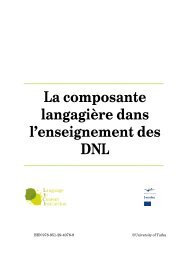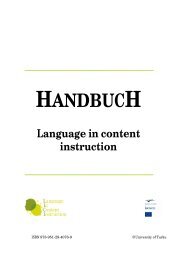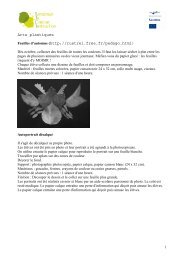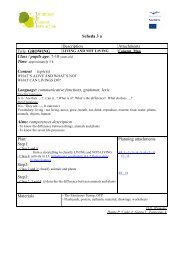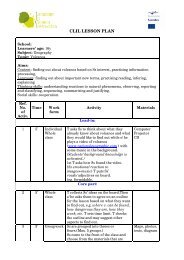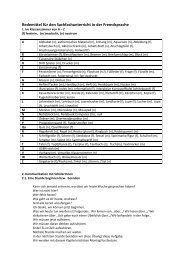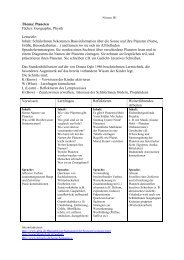Language in content instruction - LICI Project
Language in content instruction - LICI Project
Language in content instruction - LICI Project
Create successful ePaper yourself
Turn your PDF publications into a flip-book with our unique Google optimized e-Paper software.
<strong>LICI</strong> Handbook<br />
Chang<strong>in</strong>g words, phrases or sentences<br />
<strong>in</strong>to L1 before <strong>in</strong>terpretation.<br />
Anticipat<strong>in</strong>g <strong>content</strong>s before and<br />
dur<strong>in</strong>g listen<strong>in</strong>g<br />
Develop<strong>in</strong>g an awareness or an action<br />
plan of what needs to be done to<br />
accomplish a listen<strong>in</strong>g task, or mak<strong>in</strong>g<br />
predictions while listen<strong>in</strong>g.<br />
Writ<strong>in</strong>g down key words and concepts<br />
while listen<strong>in</strong>g.<br />
Us<strong>in</strong>g knowledge of one language to<br />
facilitate listen<strong>in</strong>g <strong>in</strong> another<br />
Us<strong>in</strong>g available references about the<br />
target language, <strong>in</strong>clud<strong>in</strong>g textbooks<br />
or the previous tasks.<br />
Check<strong>in</strong>g, verify<strong>in</strong>g, or correct<strong>in</strong>g<br />
one's listen<strong>in</strong>g comprehension while<br />
perform<strong>in</strong>g a task, ma<strong>in</strong>ta<strong>in</strong><strong>in</strong>g<br />
awareness of the task demands<br />
Check<strong>in</strong>g the concentration or<br />
assess<strong>in</strong>g one's strategy use,<br />
evaluat<strong>in</strong>g task completion.<br />
Focus<strong>in</strong>g on specific <strong>in</strong>formation<br />
anticipated <strong>in</strong> the message.<br />
Focus<strong>in</strong>g more generally on the task<br />
demands and <strong>content</strong>.<br />
40<br />
F<strong>in</strong>d L1 equivalents for selected key words.<br />
Translate a sequence of utterances.<br />
Work on the vocabulary and the phrases <strong>in</strong> the text by match<strong>in</strong>g<br />
the L1 equivalents with the target language expressions before,<br />
dur<strong>in</strong>g or after listen<strong>in</strong>g.<br />
Predict general <strong>content</strong>s before listen<strong>in</strong>g us<strong>in</strong>g contexts and prior<br />
knowledge.<br />
Predict details and unf<strong>in</strong>ished utterances us<strong>in</strong>g contexts and prior<br />
knowledge.<br />
Show students a visual or <strong>in</strong>troduce key vocabulary to let them<br />
predict the topic of the listen<strong>in</strong>g task.<br />
Preview <strong>content</strong>s <strong>in</strong> different forms.<br />
Rehearse the pronunciation of potential <strong>content</strong> words.<br />
Establish purpose for listen<strong>in</strong>g.<br />
Do perception practice regularly ( listen to how new vocabulary<br />
items are pronounced, follow along with transcript of record<strong>in</strong>g,<br />
write down <strong>content</strong> words from short passages, identify mean<strong>in</strong>g<br />
groups <strong>in</strong> sentences of vary<strong>in</strong>g lengths, identify tones and their<br />
communicative value, identify common discourse markers and<br />
their functions, identify common phrasal verbs and their mean<strong>in</strong>g,<br />
identify the most prom<strong>in</strong>ent word <strong>in</strong> short utterances.)<br />
Make sure students understand what is expected from them by<br />
gett<strong>in</strong>g them to repeat the <strong>in</strong>structions or ask<strong>in</strong>g them questions<br />
about the <strong>in</strong>structions.<br />
Take short notes of important <strong>content</strong> words.<br />
Agree on symbols to be used at note tak<strong>in</strong>g <strong>in</strong> general and before<br />
each listen<strong>in</strong>g task <strong>in</strong> particular.<br />
Make a list of cognates<br />
Provide opportunities for the students to flip through relevant<br />
<strong>in</strong>formation <strong>in</strong> their textbook, workbook, notes, previous exercises<br />
or handbooks and the <strong>in</strong>ternet.<br />
Check current comprehension with context of the message and<br />
prior knowledge.<br />
Cont<strong>in</strong>ue to listen for clarification <strong>in</strong> spite of difficulty.<br />
Redirect attention to task.<br />
Encourage note tak<strong>in</strong>g of difficult expressions or ideas to return to<br />
after listen<strong>in</strong>g.<br />
Evaluate comprehension us<strong>in</strong>g contexts, prior knowledge and<br />
external resources.<br />
Determ<strong>in</strong>e potential value of subsequent parts of <strong>in</strong>put.<br />
Listen selectively accord<strong>in</strong>g to purpose.<br />
Listen for gist.<br />
Determ<strong>in</strong>e the potential value of subsequent parts and vary<br />
<strong>in</strong>tensity of attention accord<strong>in</strong>gly.<br />
Memorise words or phrases for later process<strong>in</strong>g.




